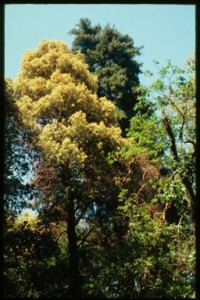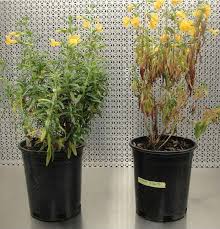tanoak killed by sudden oak death; Marin County, Calif. photo F.T. Campbell
Here is some interesting information from recent issues of the the California Oak Mortality Task Force’s bimonthly newsletter. I am updating my earlier blogs on the status of Phytophthoras and sudden oak death (SOD) in the United States and Europe.
- The SOD pathogen (Phytophthora ramorum) persists in streams in the Southeast:
More than 600 samples were taken from streams or ponds in nine states (Alabama, Florida, Georgia, Mississippi, North Carolina, Pennsylvania, South Carolina, Tennessee, and Texas) during 2016. Ten of the samples were positive: seven from three streams in Alabama and three from one stream in Mississippi. Each of these had tested positive before; none was a new positive location. [March newsletter]
- The disease continues to spread in Oregon and California:
During 2016 and early 2017, sudden oak death and tanoak mortality continued to intensify within the officially designated quarantine zone in southwest Oregon. So far, no new outbreaks have been detected outside the quarantine zone.
In Oregon, there is growing concern about the disease and the paucity of funds to address it. As a result, Oregon state Representative David Brock Smith and U.S. Senator Jeff Merkley have formed an Oregon Sudden Oak Death Task Force. The Task Force is developing a collaborative action plan to secure enough funding to contain the infestations of the NA1 genetic strain (the one widespread in Oregon and California) and to eradicate the EU1 lineage (this is the only known site where this strain is established in the forest in North America; see my blog from August 2015, which explains the significance of these strains.) [March newsletter]
In California, scientists have been surprised by the intensity of the disease in several parks on the eastern side of San Francisco Bay – an area that is drier than most forests that are infested. The severe drought of recent years has not prevented spread of the disease. Even more surprising, one park has very little California bay laurel – which is considered to be the primary source of infection. [March newsletter]
- Native plant nurseries may be spreading various Phytophthoras (see my blog from last year here) or the presentations on “Phytophthora Detections in Native Plant Nurseries and Restoration Sites” posted here)
The National Ornamentals Research Site at Dominican University (NORS-DUC) sampled several types of native plant nurseries in fall 2016 to determine the extent of movement of Phytophthora species on plants they sell. Unfortunately, the report in the newsletter did not include results of the sampling. [January 2017]
CFDA photo of herbaceous plants with Phytophthora infection
Oregon and Washington authorities acted in response to the initial reports from the San Francisco area, and sampled nurseries in their states. They found a similarly high infestation rate in native plant nurseries in their states. Washington State University and Oregon State University have held several 2 ½-day workshops on “Preventing Phytophthora Contamination in Native Plant Nurseries and Restoration Sites”. [May newsletter]
For more information about Phytophthoras in native herbaceous plants in California, visit http://ucanr.edu/sites/sod6/Proceedings/Presentations_and_Posters/ and www.calphytos.org
- Disease costs in England and Wales could top 1 billion dollars
Drake and Jones have estimated that damage by Phytophthora ramorum and P. kernoviae [link to Gallery] to non-extractive public use and non-use values at risk from uncontrolled spread of these diseases in England and Wales is £1.446 billion per year (approximately $US 1.82 billion). The greatest public value at risk (slightly more than one-third) is from an uncontrolled spread of these diseases to heritage gardens; lower risks are to the diseases’ spread to woodlands and heathlands. [March newsletter]
5) Ireland resembles Europe in numbers of Phytophthora species:
O’Hanlan and colleagues tested more than 11,000 samples from both “trade” environments (presumably, nurseries) and “non-trade” environments (presumably plantings or natural environments). They detected 19 species and 3 informally designated taxa of Phytophthora, including 8 new records for Ireland. Thus, Ireland’s situation is similar to that in Europe more broadly – a study last year by Junker and colleagues report the detection of 15 Phytophthora species in two commercial woody ornamental nurseries [link to blog about Phythophs in Europe] In Ireloand, P. ramorum was found on 30 hosts; P. syringae on 6 hosts; P. kernoviae on 3 hosts. Phytophthora species were most frequently detected on rhododendrons – (12 Phytophthora species). [January newsletter]
SOURCES
Drake, B. and Jones, G. 2017. Public Value at Risk from Phytophthora ramorum and Phytophthora kernoviae Spread in England and Wales. Journal of Environmental Management. 191: 136–144.
Junker, C., Goff, P., Wagner, S., and Werres, S. 2016. Occurrence of Phytophthora in commercial nursery production. Plant Health Progress. 17:64-75.
O’Hanlon, R.; Choiseul, J.; Corrigan, M.; Catarame, T.; and Destefanis, M. 2016. Diversity and Detections of Phytophthora Species from Trade and Non-Trade Environments in Ireland. EPPO Bull. 46: 594–602. DOI: 10.1111/epp.12331.
Posted by Faith Campbell
We welcome comments that supplement or correct factual information, suggest new approaches, or promote thoughtful consideration. We post comments that disagree with us — but not those we judge to be not civil or inflammatory.

